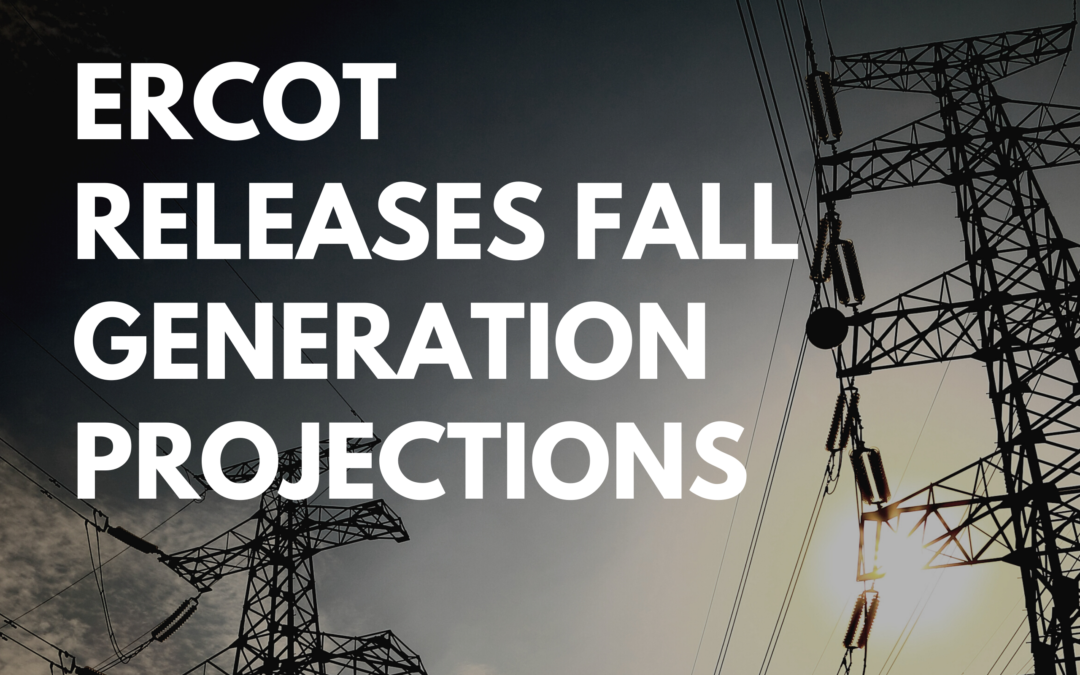A new ERCOT report shows fall operating reserves of 27,771 megawatts under normal weather conditions.
________________________________________________

Find definitions of “Seasonal Assessment of Resource Adequacy” “Energy Emergency Alert” and other key ERCOT terms in this online glossary.
Oln September 3, ERCOT released its Final Seasonal Assessment of Resource Adequacy (SARA Report) for Fall of 2021. The SARA forecasts seasonal operating reserves under a set of operating scenarios, now including extreme scenarios. The scenarios help explain conditions that could lead to an Energy Emergency Alert (EEA). The SARA Reports for what have traditionally been the shoulder months — which are those typically characterized by extremely high reserves — have received much greater scrutiny in the last few years as tight conditions have arisen on several occasions during seasonal maintenance windows.
The Supply Analysis Working Group of the Wholesale Market Subcommittee at ERCOT continues to develop a “probabilistic” SARA that will more comprehensively depict the full array of shortage risks. The probabilistic SARA will likely supplement the current report rather than fully displace it.
UNDER NORMAL WEATHER CONDITIONS
Under normal weather conditions, the SARA indicates a seasonal peak of 62,662 megawatts, with total system resources of 90,433 MW, for operating reserves of 27,771 MW. Some of the relevant details of the resource calculation include the following:
- 64,665 MW thermal and hydro resources
- 10,317 MW wind capacity (measured as 35 percent installed capacity coastal; 44 percent installed capacity Panhandle; 37 percent installed capacity other wind locations)
- 3,641 MW solar capacity (measured at 68 percent of rated capacity)
- 5,276 MW planned resources available for fall 2021 (856 MW thermal, 1,969 MW wind, 2451 MW solar)
The scenario analysis assesses combinations of the following:
- Unseasonably high heat calling for 12,737 additional MW
- Typical thermal planned outages of 4,103 MW
- Typical unplanned outages of 10,671 MW
- High unplanned outages of 4,965 MW
- Low wind output reducing total renewables on peak by 13,685 MW
Under two combinations assessed, insufficient operating reserves would lead to an EEA event. Those scenarios are the following:
- Expected load; expected thermal outages; low wind/solar output
- High heat; expected thermal outages; expected renewables
EXTREME SCENARIOS
ERCOT then assessed several extreme scenarios. Each of these scenarios stack additional extreme conditions on the prior scenario, and each combination of extreme scenarios would lead to an EEA. The elements of the extreme scenarios are the following:
- Unseasonably high heat calling for 12,737 additional MW
- Typical thermal planned outages of 4,103 MW
- Typical unplanned outages of 10,671 MW
- High unplanned outages of 4,965 MW
- Low wind output reducing total renewables on peak by 13,685 MW
- Extreme unplanned thermal outages 1,460 MW
In the most extreme of the cases (in which every one of these conditions occurs simultaneously), the operating reserve would be short by 19,849 MW at peak, a much larger value than the 2,212 MW of Ancillary Services and Load Resources that are available for ERCOT to deploy during an EEA event.
Although it is extremely difficult to assess the likelihood of such extreme scenarios occurring simultaneously, the probabilistic SARA still under development should help because it will put such scenarios into better statistical context. Moreover, new legislation that requires ERCOT to better coordinate maintenance outages with generators should mitigate some degree of risk during shoulder months.
More information about the “Wholesale Market Subcommittee,” the “Seasonal Assessment of Resource Adequacy (SARA Report)” and other key ERCOT groups and concepts can be found at this online ERCOT glossary, found here.

